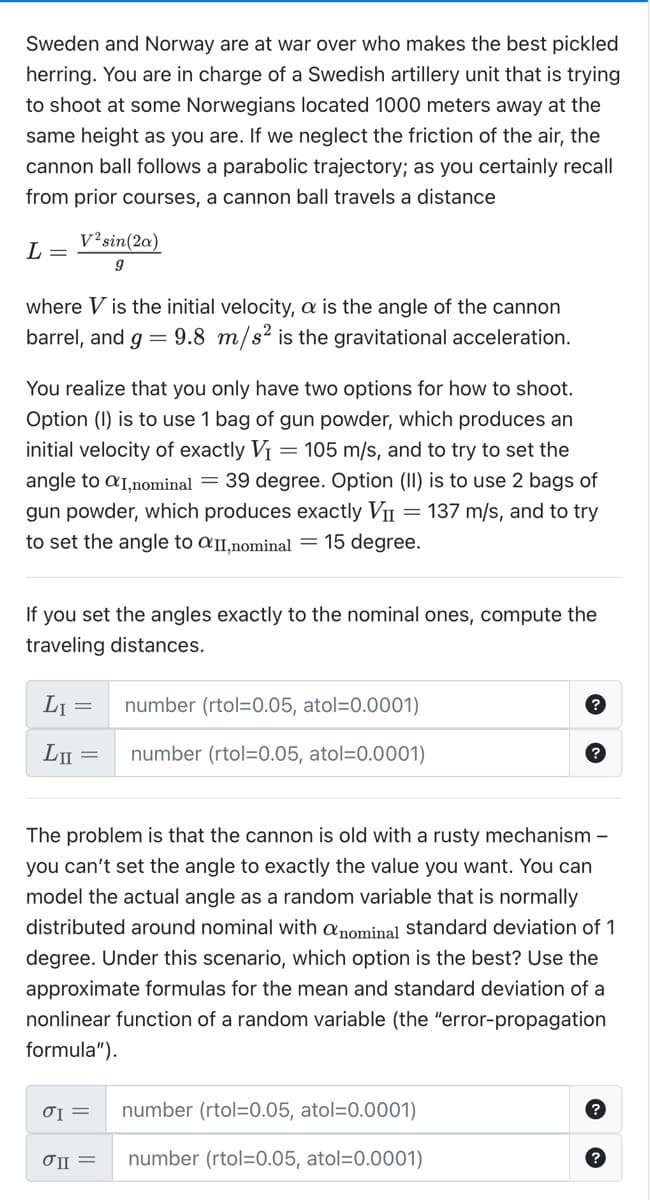Sweden and Norway are at war over who makes the best pickled herring. You are in charge of a Swedish artillery unit that is trying to shoot at some Norwegians located 1000 meters away at the same height as you are. If we neglect the friction of the air, the cannon ball follows a parabolic trajectory; as you certainly recall from prior courses, a cannon ball travels a distance L = V² sin(2a) 9 where Vis the initial velocity, a is the angle of the cannon barrel, and g = 9.8 m/s² is the gravitational acceleration. You realize that you only have two options for how to shoot. Option (1) is to use 1 bag of gun powder, which produces an initial velocity of exactly V₁ = 105 m/s, and to try to set the angle to αI,nominal = 39 degree. Option (II) is to use 2 bags of gun powder, which produces exactly V₁ = 137 m/s, and to try to set the angle to αII,nominal = 15 degree. If you set the angles exactly to the nominal ones, compute the traveling distances. L₁ = LII = number (rtol=0.05, atol-0.0001) number (rtol=0.05, atol-0.0001) ? ?
Sweden and Norway are at war over who makes the best pickled herring. You are in charge of a Swedish artillery unit that is trying to shoot at some Norwegians located 1000 meters away at the same height as you are. If we neglect the friction of the air, the cannon ball follows a parabolic trajectory; as you certainly recall from prior courses, a cannon ball travels a distance L = V² sin(2a) 9 where Vis the initial velocity, a is the angle of the cannon barrel, and g = 9.8 m/s² is the gravitational acceleration. You realize that you only have two options for how to shoot. Option (1) is to use 1 bag of gun powder, which produces an initial velocity of exactly V₁ = 105 m/s, and to try to set the angle to αI,nominal = 39 degree. Option (II) is to use 2 bags of gun powder, which produces exactly V₁ = 137 m/s, and to try to set the angle to αII,nominal = 15 degree. If you set the angles exactly to the nominal ones, compute the traveling distances. L₁ = LII = number (rtol=0.05, atol-0.0001) number (rtol=0.05, atol-0.0001) ? ?
Elements Of Electromagnetics
7th Edition
ISBN:9780190698614
Author:Sadiku, Matthew N. O.
Publisher:Sadiku, Matthew N. O.
ChapterMA: Math Assessment
Section: Chapter Questions
Problem 1.1MA
Related questions
Question

Transcribed Image Text:Sweden and Norway are at war over who makes the best pickled
herring. You are in charge of a Swedish artillery unit that is trying
to shoot at some Norwegians located 1000 meters away at the
same height as you are. If we neglect the friction of the air, the
cannon ball follows a parabolic trajectory; as you certainly recall
from prior courses, a cannon ball travels a distance
L =
V²sin(2a)
9
where V is the initial velocity, a is the angle of the cannon
barrel, and g = 9.8 m/s² is the gravitational acceleration.
You realize that you only have two options for how to shoot.
Option (I) is to use 1 bag of gun powder, which produces an
initial velocity of exactly V₁ = 105 m/s, and to try to set the
angle to aI,nominal = 39 degree. Option (II) is to use 2 bags of
gun powder, which produces exactly VII = 137 m/s, and to try
to set the angle to aII,nominal = 15 degree.
If you set the angles exactly to the nominal ones, compute the
traveling distances.
L₁ =
LII
=
The problem is that the cannon is old with a rusty mechanism -
you can't set the angle to exactly the value you want. You can
model the actual angle as a random variable that is normally
distributed around nominal with a nominal standard deviation of 1
degree. Under this scenario, which option is the best? Use the
approximate formulas for the mean and standard deviation of a
nonlinear function of a random variable (the "error-propagation
formula").
σI =
number (rtol=0.05, atol=0.0001)
number (rtol=0.05, atol=0.0001)
σII =
number (rtol=0.05, atol=0.0001)
number (rtol=0.05, atol=0.0001)
Expert Solution
This question has been solved!
Explore an expertly crafted, step-by-step solution for a thorough understanding of key concepts.
This is a popular solution!
Trending now
This is a popular solution!
Step by step
Solved in 3 steps

Knowledge Booster
Learn more about
Need a deep-dive on the concept behind this application? Look no further. Learn more about this topic, mechanical-engineering and related others by exploring similar questions and additional content below.Recommended textbooks for you

Elements Of Electromagnetics
Mechanical Engineering
ISBN:
9780190698614
Author:
Sadiku, Matthew N. O.
Publisher:
Oxford University Press

Mechanics of Materials (10th Edition)
Mechanical Engineering
ISBN:
9780134319650
Author:
Russell C. Hibbeler
Publisher:
PEARSON

Thermodynamics: An Engineering Approach
Mechanical Engineering
ISBN:
9781259822674
Author:
Yunus A. Cengel Dr., Michael A. Boles
Publisher:
McGraw-Hill Education

Elements Of Electromagnetics
Mechanical Engineering
ISBN:
9780190698614
Author:
Sadiku, Matthew N. O.
Publisher:
Oxford University Press

Mechanics of Materials (10th Edition)
Mechanical Engineering
ISBN:
9780134319650
Author:
Russell C. Hibbeler
Publisher:
PEARSON

Thermodynamics: An Engineering Approach
Mechanical Engineering
ISBN:
9781259822674
Author:
Yunus A. Cengel Dr., Michael A. Boles
Publisher:
McGraw-Hill Education

Control Systems Engineering
Mechanical Engineering
ISBN:
9781118170519
Author:
Norman S. Nise
Publisher:
WILEY

Mechanics of Materials (MindTap Course List)
Mechanical Engineering
ISBN:
9781337093347
Author:
Barry J. Goodno, James M. Gere
Publisher:
Cengage Learning

Engineering Mechanics: Statics
Mechanical Engineering
ISBN:
9781118807330
Author:
James L. Meriam, L. G. Kraige, J. N. Bolton
Publisher:
WILEY